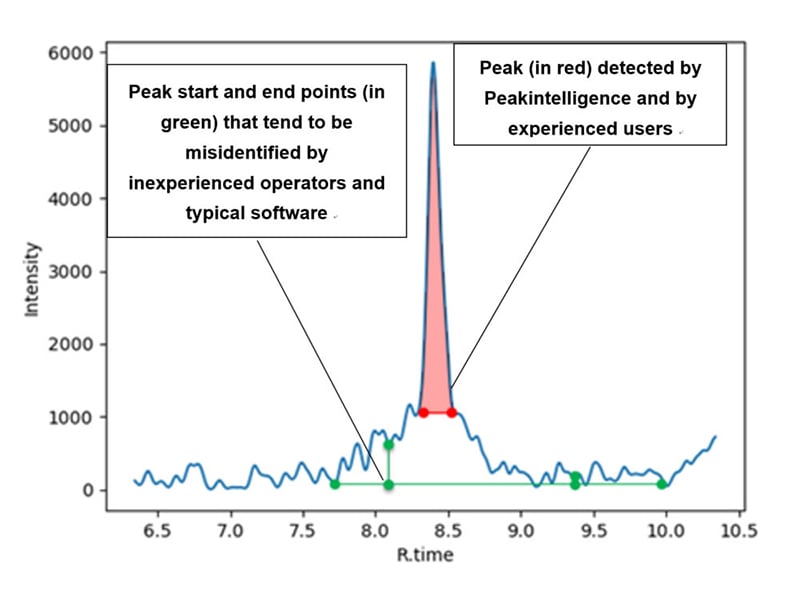September 25, 2019 | News & Notices Shimadzu’s New Peak Picking Software for LC-MS/MS Simplifies Data Analysis and Enables a More Productive Laboratory
Shimadzu announces the release of Peakintelligence software for triple quadrupole liquid chromatograph mass spectrometers (LC-MS/MS). Equipped with algorithms developed using artificial intelligence (AI), the optional Peakintelligence software automatically detects peaks*1 that appear frequently in the software window. The software replaces the conventional process of visual confirmation by the operator, thereby reforming the work environment at research sites. Developed through collaborative research with Fujitsu Limited*2, this product works with LC-MS/MS systems utilizing method packages for primary metabolites and cell culture profiling*3.
As mass spectrometers have evolved, the amount of data obtained from them has become massive. As a result, when analyzing the data, the procedure known as peak picking*4 has become a bottleneck because it requires visual confirmation of multiple peaks. Further, the accuracy of data analysis varies from operator to operator and the falsification of data is a possibility. At research sites in the life sciences dealing with medical treatments and drug discovery, for example, the automation of high-accuracy peak picking, which would eliminate dependency on operator expertise, has been a highly sought-after development.
Since 2016, Shimadzu and Fujitsu have been conducting collaborative research regarding automatic detection techniques for peak picking using AI. Shimadzu has been in charge of techniques for producing data to compensate for insufficiencies in training data*5, while Fujitsu has been in charge of feature extraction techniques for training the software with the analytical know-how of experienced operators. The 70,000 sets of training data produced were then used for training the software utilizing a deep learning function. High-accuracy levels were achieved by the AI with respect to the visual observations and manual procedures of experienced users, with a false positive detection rate of 7 % and a false negative detection rate of 9 %.
The optional Peakintelligence software is intended for use with LC-MS/MS systems in life science fields (primary metabolites and cell cultures), but the number of compatible models and fields of application is steadily expanding. Our goal at Shimadzu is to improve the operational efficiency for all Shimadzu analytical instrument users, by accumulating research and development related to AI technology, and then putting this technology to use.
*1 Peaks:
Peaks appear in the data (graphs) obtained from mass spectrometers. Their height and area indicate the amount of a compound present.
*2 Collaborative research:
During development, input regarding the needs of researchers as well as technical advice was obtained from Professor Eiichiro Fukusaki in the Graduate School of Engineering at Osaka University, and from Professor Fumio Matsuda in the Graduate School of Information Science and Technology, also at Osaka University.
Shimadzu and Osaka University have established the Osaka University Shimadzu Analytical Innovation Research Laboratory and are jointly developing analytical techniques and applications, focusing on metabolomics.
*3 Method packages:
Developed through collaborative research, these provide ready-to-use information, including optimized analytical conditions and pretreatment procedures, related to analysis for specific applications.
*4 Peak picking:
This is the process of defining peaks by determining their start and end points. With typical software, the user configures the parameters with the objective of automatic detection. However, some peaks require visual observation and revision by the operator.
*5 Training data:
This data is used to train a deep learning network. The data entered into the network becomes associated with the corresponding anticipated output. This technology matches the data output from analytical instruments with the corresponding results of peak picking by experienced users.

Features
1. AI Algorithm Provides Data Analysis Accuracy on Par with Experienced Users
When the analysis results from the AI generated algorithm (included in this product) and existing software were compared, the match to analyses by experienced users was 93.8 % for the algorithm and 87 % for existing software. (In this case, 14 samples were analyzed, and each sample contained 100 kinds of target compounds.)
2. Significantly Reduced Analysis Time
The same AI generated algorithm and existing software were compared with respect to the time required for the automatic detection of peaks and revision by visual observation. Using the conditions listed above, the algorithm took 6.3 hours whereas the existing software took 18.1 hours. The time needed for peak picking was reduced by 2/3. This time savings results in higher productivity and allows researchers to focus on more creative endeavors.
3. Adoption of a Subscription System
For the first time with a Shimadzu software product, a subscription system has been adopted. A paid license is issued on an annual basis, enabling flexible usage in accordance with research plans. A 90-day demo version license is also available.
For more details, visit
Peakintelligence


